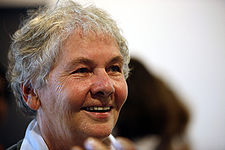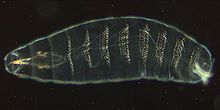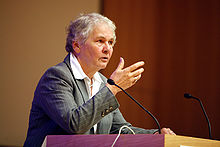- Christiane Nüsslein-Volhard
-
Christiane Nüsslein-Volhard 
Born October 20, 1942
Magdeburg, GermanyResidence Germany Nationality German Fields Biology Institutions European Molecular Biology Laboratory,
MPI for Developmental BiologyAlma mater University of Tübingen Doctoral advisor Heinz Schaller Notable awards Nobel Prize in Physiology or Medicine (1995),
Gottfried Wilhelm Leibniz Prize (1986)Christiane Nüsslein-Volhard (born October 20, 1942 in Magdeburg) is a German biologist who won the Albert Lasker Award for Basic Medical Research in 1991 and the Nobel Prize in Physiology or Medicine in 1995, together with Eric Wieschaus and Edward B. Lewis, for their research on the genetic control of embryonic development.
Contents
The experiments that earned Nüsslein-Volhard and Wieschaus their Nobel prize aimed to identify genes involved in the development of Drosophila melanogaster (fruit fly) embryos. At this point (the late 1970s and early 1980s) little was known about the genetic and molecular mechanisms by which multicellular organisms develop from single cells to morphologically complex forms during embryogenesis.
Fruit flies have long been an important model organism in genetics due to their small size and quick generation time, which makes even large numbers of them relatively easy to maintain and observe in the laboratory.[1] Nüsslein-Volhard and Wieschaus identified genes involved in embryonic development by a series of genetic screens. They generated random mutations in fruit flies using a chemical. Some of these mutations affected genes involved in the development of the embryo. Nüsslein-Volhard and Weischaus took advantage of the segmented form of Drosophila larvae to address the logic of the genes controlling development. In normal unmutated Drosophila, each segment produces bristles called denticles in a band arranged on the side of the segment closer to the head (the anterior). The researchers looked at the pattern of segments and denticles in each mutant under the microscope, and were therefore able to work out that particular genes were involved in different processes during development based on their differing mutant phenotypes (such as fewer segments, gaps in the normal segment pattern, and alterations in the patterns of denticles on the segments).[2] Many of these genes were given descriptive names based on the appearance of the mutant larvae, such as hedgehog, gurken (German: "cucumbers"), and Krüppel ( "cripple"). Later, researchers identified exactly which gene had been affected by each mutation, thereby identifying a set of genes crucial for Drosophila embryogenesis. The subsequent study of these mutants and their interactions led to important new insights into early Drosophila development, especially the mechanisms that underlie the step-wise development of body segments.
These experiments are not only distinguished by their sheer scale (with the methods available at the time, they involved an enormous workload), but more importantly by their significance for organisms other than fruit flies. It was later found that many of the genes identified here had homologues in other species. In particular, the homeobox genes (coding for transcription factors critically involved in early body development) are found in all metazoans, and usually have similar roles in body segmentation.
These findings have also led to important realizations about evolution - for example, that protostomes and deuterostomes are likely to have had a relatively well-developed common ancestor with a much more complex body plan than had been conventionally thought.
Additionally, they greatly increased our understanding of the regulation of transcription, as well as cell fate during development.
Nüsslein-Volhard is associated with the discovery of Toll, which led to the identification of toll-like receptors.[3]
Since 1985 Christiane Nüsslein-Volhard has been Director of the Max Planck Institute for Developmental Biology in Tübingen and also leads its Genetics Department. In 1986, she received the Gottfried Wilhelm Leibniz Prize of the Deutsche Forschungsgemeinschaft, which is the highest honour awarded in German research. Since 2001 she has been member of the Nationaler Ethikrat (National Ethics Council of Germany) for the ethical assessment of new developments in the life sciences and their influence on the individual and society. Her primer for the lay-reader, Coming to Life: How Genes Drive Development was published in April 2006.
In 2004 Nüsslein-Volhard started the Christiane Nüsslein-Volhard Foundation (Christiane Nüsslein-Volhard Stiftung). It is meant to aid promising young female German scientists with children. The foundation's main focus is to facilitate childcare as a supplement to existing stipends and day care.
Honorary degrees
Christiane Nüsslein-Vollhard has been awarded an honorary degree by the following Universities:
- Yale
- Harvard
- Princeton
- Rockefeller
- Utrecht
- UC London
- Oxford University (June 2005)
- Sheffield
- St Andrews University (June 2011)
- Freiburg
- Munich
- List of female Nobel laureates
- 15811 Nüsslein-Volhard, an asteroid named after Christiane Nüsslein-Volhard
- ^ Arias AM (2008). "Drosophila melanogaster and the development of biology in the 20th century". Methods Mol. Biol.. Methods in Molecular Biology 420: 1–25. doi:10.1007/978-1-59745-583-1_1. ISBN 978-1-58829-817-1. PMID 18641938.
- ^ Nüsslein-Volhard C, Wieschaus E (October 1980). "Mutations affecting segment number and polarity in Drosophila". Nature 287 (5785): 795–801. doi:10.1038/287795a0. PMID 6776413.
- ^ "Toll To Be Paid at the Gateway to the Vessel Wall -- Hansson and Edfeldt 25 (6): 1085 -- Arteriosclerosis, Thrombosis, and Vascular Biology". http://atvb.ahajournals.org/cgi/content/full/25/6/1085. Retrieved 2007-11-10.
- Christiane Nüsslein-Volhard's homepage
- Gradients That Organize Embryo Development, (Scientific American, August 1996)
- Nobel lecture
- Smithsonian magazine interview
- Christiane Nüsslein-Volhard Stiftung (Christiane Nüsslein-Volhard Foundation)
- The Official Site of Louisa Gross Horwitz Prize
Categories:- 1942 births
- Members of the European Molecular Biology Organization
- Living people
- Members of the United States National Academy of Sciences
- Nobel laureates in Physiology or Medicine
- Geneticists
- German biochemists
- Foreign Members of the Royal Society
- Grand Crosses with Star and Sash of the Order of Merit of the Federal Republic of Germany
- Recipients of the Pour le Mérite (civil class)
- German Nobel laureates
- Leibniz Prize winners
- People from Magdeburg
- Women scientists
- Goethe University Frankfurt alumni
- University of Tübingen alumni
- University of Tübingen faculty
- Women Nobel laureates
Wikimedia Foundation. 2010.


